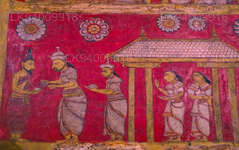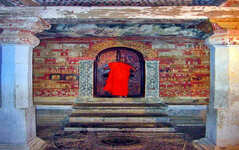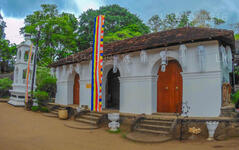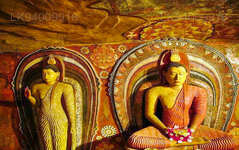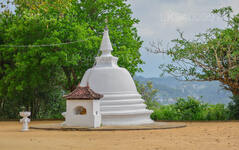
Kandy-stad
Kandy, een pittoreske stad in centraal Sri Lanka, staat bekend om zijn rijke culturele erfgoed, levendige festivals en schilderachtige schoonheid. Gelegen tussen weelderige heuvels, herbergt de stad de Tempel van de Tand, een UNESCO-werelderfgoed, en biedt een fascinerende mix van geschiedenis en natuurlijke pracht.
Degaldoruwa Raja Maha Vihara
Amongst the rocky slopes and green valleys of rural Kandy lies a hidden treasure; the Degaldoruwa Raja Maha Vihara. This temple awes those who view it with its incredible Kandyan era frescoes. Construction of the temple began in the late 1770s under the reign of King Kirti Sri Rajasinha and was completed under the reign of his brother Rajadhi Rajasinha years later.
Legend
According to folklore a farmer was exploring the area and found a crevice between two rocks. On venturing into space he found a cave with a pile of golden sickles. The farmer was delighted with his discovery but feared retribution from some strange power. So he simply took only one sickle every morning and, after using it in his fields, returned it in the evening. His fields yielded an extremely healthy harvest and the farmer attributed it to the golden sickle. But then he became greedy. After all, he had been taking the sickles every day and there had been no ill effects, and there was a whole pile of them. So on the very last day of the harvest, he took two sickles instead of one and did not return one of them.
But unknown to the farmer, there had indeed been a guardian for the treasure. The guardian noticed the farmer taking the sickles, but kept quiet as he always returned them. On the day that the farmer took one sickle for himself, the guardian saw it at once and confronted him in his home. The terrified farmer immediately rushed to the crevice and returned the golden sickle that he had stolen. The guardian, who had been disappointed, then sealed the crevice by fusing the two rocks together. However, the villagers got to know this story and informed the king, Kirti Sri Rajasinha; who then ordered that the cave be found and a temple erected in it.
The Structure
- The temple is hollowed out of a 40 foot rock outcrop extending a natural cave. It consists of an elegant rock shelter with two roofed antechambers in front; a drummers’ hall and an image house; and the main shrine room cut into the rock itself. The two antechambers are constructed outside the rock outcrop and have wooden roofs.
- The architecture is unusual for the period as the drummers’ hall is not usually attached to the main temple.
- The image house is located through a set of old wooden doors, situated under a carved wooden Dragon Arch. It preserves a moonstone and a sequence of elaborate and colorful paintings showing scenes from four Jātaka tales, which tell the stories of the previous lives of Buddha.
- The door of the shrine room is banded with metal and once had jewels embedded within it. The inner walls of the shrine are completely covered in paintings; including the door.
- In addition to this main structure, there is a bo tree and a stupa on a plateau on the summit of the rocky outcrop above the temple. They can be reached by stairs carved into the temple.
The Frescoes
The paintings of Degaldoruwa, which are supposed to be some of the best of the Kandyan era, are believed to be the work of four ‘Sittara’ artists. The finest of these paintings grace the ceiling of the temple; ‘Mara Yudde’, an artistic depiction of Buddha’s internal spiritual battle against Māra, the demon of death, rebirth, and desire.
The murals are unique in that all the elements; the people, the trees and the animals; are a uniform size and only the front views of ]people are shown. The trees have a stylized form, with their branches and leave spreading out to either side. The individual elements, such as the adornments on the elephants and the uniforms of the attendants, are portrayed in great detail. All of the colors used by the artists in the murals were created from the barks
Over het district Kandy
Het district Kandy ligt in de centrale provincie van Sri Lanka. Kandy, een van de zeven werelderfgoedlocaties in Sri Lanka, was ooit de thuisbasis van de Kandyaanse koningen van weleer in de 16e eeuw en een bron voor alle muziek, kunst, ambachten en cultuur in het land. Kandy ligt op ongeveer 129 km van Colombo en is genesteld in een heuvelachtig terrein en alle ogen worden getrokken naar het centrum van de stad, waar het Kandy-meer een charmant kenmerk vormt. Kandy behoudt een grote religieuze betekenis voor Sri Lanka, omdat in deze charmante stad de Dalada Maligawa of "Tempel van de Tand" zich bevindt, waarin de heilige tand van Boeddha goed bewaard wordt. De Koninklijke Botanische Tuin, Peradeniya, ligt ongeveer 5 km ten westen van het stadscentrum in Peradeniya en wordt jaarlijks door 1,2 miljoen mensen bezocht. Het is de grootste botanische tuin op het eiland. De Udawatta Kele (Udawatta-bos) is een beschermd heiligdom in het hart van de stad, net ten noorden van de Tempel van de Tand. Kandy is een stad met een Sinhalese meerderheid; er zijn aanzienlijke gemeenschappen die behoren tot andere etnische groepen, zoals Moren en Tamils. Kandy is, na Colombo, het centrum van de Sri Lankaanse economie. Veel grote bedrijven hebben grote vestigingen in Kandy en veel industrieën, waaronder textiel, meubels, informatietechnologie en sieraden, zijn hier te vinden. Veel landbouwonderzoekscentra bevinden zich in de stad. Het is tevens een bron van alle muziek, kunst, ambachten en cultuur van het land. Op ongeveer 129 km van Colombo ligt Kandy verscholen in een heuvelachtig gebied en alle ogen worden getrokken naar het centrum van de stad, waar het Kandymeer een charmant kenmerk vormt. Kandy heeft een grote religieuze betekenis voor Sri Lanka, omdat in deze charmante stad de Dalada Maligawa, oftewel Tempel van de Tand, is gevestigd, waar de heilige tand van Boeddha goed bewaard wordt.
Over de Centrale Provincie
De Centrale Provincie van Sri Lanka bestaat voornamelijk uit bergachtig terrein. De provincie heeft een oppervlakte van 5.674 km² en een bevolking van 2.421.148. Enkele belangrijke steden zijn Kandy, Gampola (24.730), Nuwara Eliya en Bandarawela. De bevolking is een mix van Singalezen, Tamils en Moren. Zowel de heuvelhoofdstad Kandy als de stad Nuwara Eliya, evenals Sri Pada, liggen in de Centrale Provincie. De provincie produceert een groot deel van de beroemde Ceylonthee, die in de jaren 1860 door de Britten werd geplant nadat een verwoestende ziekte alle koffieplantages in de provincie had vernietigd. De Centrale Provincie trekt veel toeristen, met heuvelstadjes zoals Kandy, Gampola, Hatton en Nuwara Eliya. De Tempeltand, of Dalada Maligawa, is de belangrijkste heilige plaats in de provincie Centrel. Het klimaat is koel en veel gebieden boven de 1500 meter hoogte hebben vaak koude nachten. De westelijke hellingen zijn erg nat, met op sommige plaatsen bijna 7000 mm regen per jaar. De oostelijke hellingen behoren tot de middeldroge zone, omdat ze alleen regen ontvangen van de noordoostelijke moesson. De temperaturen variëren van 24 °C in Kandy tot slechts 16 °C in Nuwara Eliya, dat 1889 m boven zeeniveau ligt. De hoogste bergen van Sri Lanka liggen in de Centrale Provincie. Het terrein is overwegend bergachtig, met diepe valleien die het doorsnijden. De twee belangrijkste berggebieden zijn het Centraal Massief en het Knuckles-gebergte ten oosten van Kandy.


